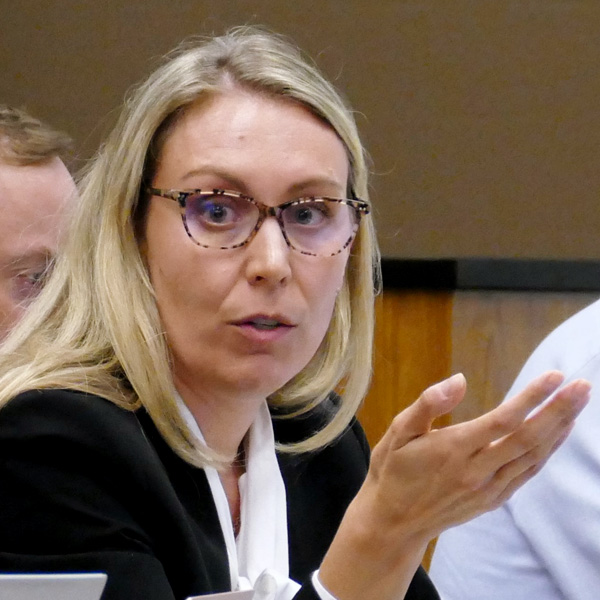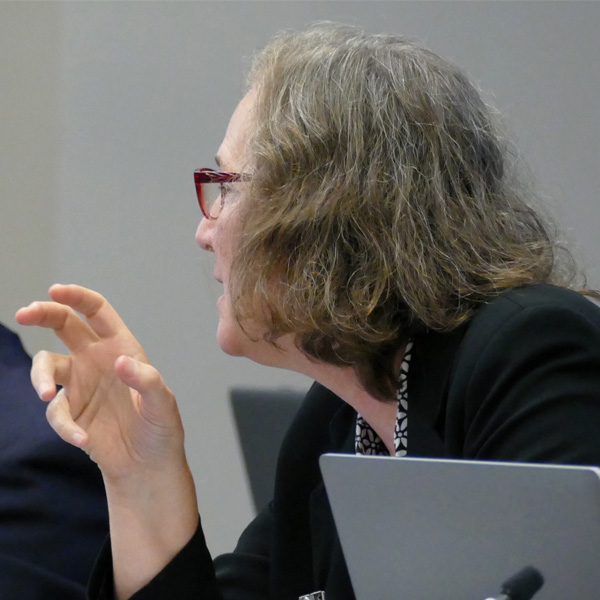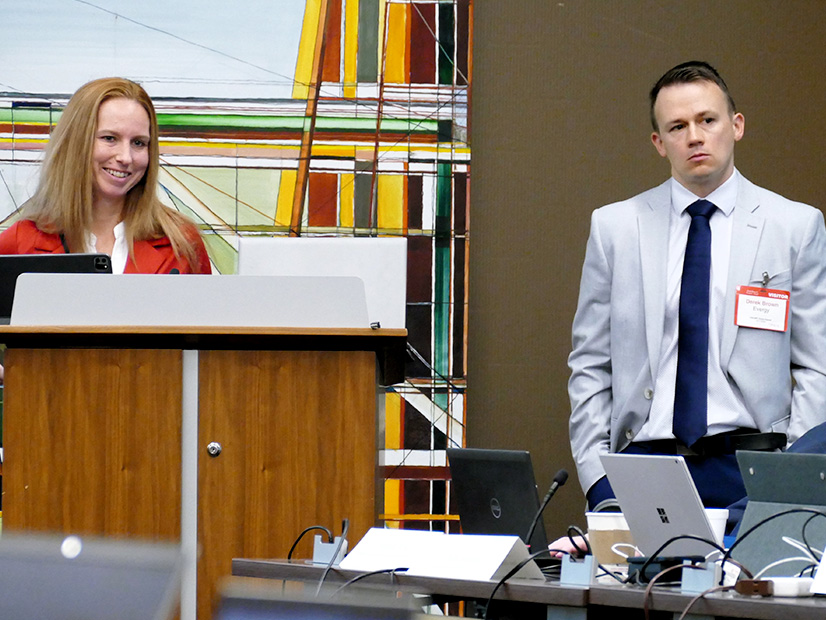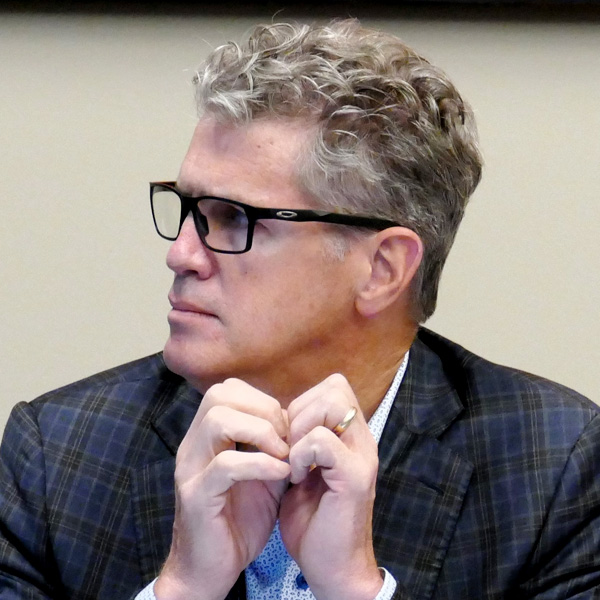COVINGTON, Ky. — Participants at the Organization of PJM States Inc. (OPSI) annual meeting debated PJM’s recent capacity market filing and whether the RTO next needs to consider changes to its energy and reserve markets to ease the transition to increasing volumes of intermittent resources.
Transparency Faulted on CIFP Filing
During a session discussing PJM’s proposed capacity market changes, James Wilson, a consultant to state consumer advocates, said the critical issue fast path (CIFP) process that resulted in PJM’s filing lacked the information sharing needed to adequately evaluate how specific provisions could impact rates or reliability. In particular, he said changes to the variable resource requirement curve would reduce the amount of unforced capacity (UCAP) available on the capacity market by around 25,000 MW. (See PJM Files Capacity Market Revamp with FERC.)
PJM Vice President of Market Design and Economics Adam Keech said the proposal would balance the reduced UCAP by reducing the amount of capacity that load will have to procure. Correlated outage risk, for instance, will be shifted from being on the demand side of the auction to supply.
“While, yes, the supply side is going down, I want to be clear that the demand side is going down,” Keech said.
Paul Sotkiewicz, president of E-Cubed Policy Associates, said he believes the CIFP process tried to do too much too fast and that when ISO-NE considered a shift to a seasonal capacity market — which was part of PJM’s initial proposal that did not make it into the final filing — its stakeholder process spanned years with considerable data produced.
Sotkiewicz said changes to the capacity performance (CP) penalty structure and how it would interact with other market structures isn’t fully understood. He noted that the proposal — which would redefine the annual stop-loss limit to be based on Base Residual Auction clearing prices, rather than the cost of new entry — comes on the heels of FERC’s August approval of changes to the triggers that initiate the performance assessment intervals that expose resources to CP penalties. (See FERC Approves PJM Change to Emergency Triggers.)
Wilson said the CP changes could have a significant impact but that the amount of data that was presented during the CIFP process made it difficult for stakeholders to produce their own estimates of the effect on the capacity performance quantified risks that generators can include in their capacity offers.
“Is this a big thing or a little thing? I’ve never gotten a good answer,” he said, adding that there’s a potential for consumers to take on a significant amount of risk.
Michelle Bloodworth, CEO of coal lobby America’s Power, said the risks present in the capacity market have been “vastly underestimated,” particularly due the number of environmental rules recently enacted and being considered at the federal level. The coal resources present in PJM, which she said met 47% of the incremental increased demand during the December 2022 winter storm, would be particularly at risk if PJM doesn’t consider those rules in its market design.
“With the coal fleet that we have we certainly don’t want to cause more retirements,” she said.
Both David “Scarp” Scarpignato, of Calpine, and Bloodworth said the shift to marginal effective load carrying capability (ELCC) accreditation for all capacity resources would be an improvement. Scarp said ELCC goes beyond just addressing fuel security and would capture the risks of common mode failures.
PJM Chief Outlines Work to be Done Through Clean Energy Transition
PJM CEO Manu Asthana said the RTO is well positioned as it continues to adjust to the entry of renewable energy onto the grid, but there is more work to be done to ensure those resources keep pace with deactivating fossil generators and maintain reliability through extreme weather events.
At the top of PJM’s efforts is the shift to a cluster approach for studying generation interconnection requests to clear a backlog with hundreds of GW in nameplate generation within a few years. He called it “an incredible engineering task” that is being aided by hiring additional planning staff and exploring ways of automating portions of the process.
He noted that PJM also initiated new task forces focused on generation deactivations, reserve certainty and long-term transmission planning, as well as continuing efforts to harmonize the electric and gas markets.
Asthana said he’s concerned PJM’s estimate that 43 GW of generation could retire due to federal environmental rules may be too low. The retirements are expected at the same time load growth is poised to accelerate with hydrogen hubs and artificial intelligence fueling data center proliferation.
While meeting the demand for that energy will require rapid development of new resources, Asthana said only a small number of resources that have cleared the interconnection queue have entered commercial service.
“We know that we have to continue to blaze through the interconnection queue and we’re really laser focused on that, but there are a lot of issues beyond that which have to do with … with cost pressures [and] supply chain pressures that may delay the rate at which those renewable generators show up.”
In addition to seeking to accelerate the rate of new entry, PJM also will “advocate for what we think is critical: which is we’re going to need thermal generation — which is going to include some coal and a lot of gas — to get us through this transition,” he said.
Asthana said outages in other regions during extreme weather underlined how critical grid reliability is. Outages during the February 2021 storm in Texas caused an estimated $300 billion in lost economic activity, while Europe saw around 68,000 deaths last winter related to cold weather, some of which Asthana said was related to high energy prices causing people to not heat their homes adequately.
“The commodity that we provide to our customers is at the fabric of their everyday life,” he said. “ … There’s going to be no excuse if the lights go out for an extended period of time.”
Panel Discusses Potential Changes to PJM Markets
Monday’s sessions also included obstacles to the clean energy transition left unresolved by the CIFP filing and how to ensure that renewable resources are being developed at the pace they’re needed.
Jason Barker, vice president of regulatory affairs for Vitol, said PJM’s markets are the results of decades of fine tuning to the characteristics of thermal generators, which are not universally shared by the newer generation of inverter-based resources. Seasonal or time-of-day markets would more “surgically” capture their benefits and the introduction of storage promises to be a “game-changer” with the correct market design,” he said.
State policies also could play a major role in promoting the development of clean energy by setting a cost for carbon emissions, passing environmental legislation such as the Regional Greenhouse Gas Initiative and strengthening pathways for consumers to engage in power purchase agreements, he said. “We think states should be more aggressive in setting these carbon valuations.”
Ensuring that renewable developments aren’t held up in PJM’s interconnection queue also will be necessary to allow new resource entry to keep pace with deactivations, Barker said.
Vice President of Planning Ken Seiler said there are about 40 GW of projects with signed interconnection service agreements (ISAs) that have yet to go into service, while just 4 GW have been built so far this year, most of it gas-fired.
“We need to get generation connected to the system and we need to do it expeditiously,” Seiler said during a Tuesday panel.
Abe Silverman, director of Columbia University’s Non-Technical Barriers to the Clean Energy Transition Initiative, said the preliminary results of a survey he conducted of renewable developers with projects in PJM’s interconnection queue suggest there are a multitude of challenges to getting steel in the ground even after receiving an ISA.
One of the reasons he has heard cited is that some stages of the development process, including siting and permitting, cannot begin until developers have received an ISA from PJM. When there was more certainty about when their interconnection studies would be completed, developers could begin some preparatory work, but the uncertainty has increased alongside queue times. He also said developers have pointed to inflationary pressures, macroeconomic factors and the length of the queue in general.
“When we talk about the reliability issues of future retirements in PJM, we really need to talk about the ability to do interconnection as a critical reliability service,” he said.
LS Power Senior Vice President of Wholesale Market Policy Marji Philips said that gas peaker plants will be required as a “last defense” for reliability, but are not receiving the price signals to stay in the market. One of the central challenges for gas resources remains the increased risk that they see over holiday weekends, when they may have to buy multi-day packages of fuel without knowing if they’ll be dispatched and for how long.
She argued that ELCC accreditation works well for intermittent resources like wind and solar, but it doesn’t capture the issues that affect gas-fired resource availability, namely dispatch uncertainty, fuel availability and winterization. The disparate contracts that generators have to procure their fuel and the circumstances under which it may not be delivered would be especially difficult to capture in ELCC, she said. PJM’s CIFP proposal would expand the use of ELCC accreditation to all resource types.
“Peaker performance is dependent on dispatch,” she said.
Calpine’s Scarpignato said the interaction between state renewable energy credits (RECs) and PJM’s energy market design results in many resources entering zero price offers and renewable resources being able to remain profitable even when energy prices are negative. For resources with fuel costs, he said that results in the capacity market becoming increasingly important for their revenues and makes them particularly sensitive to changes to the demand curve, which would be revised under PJM’s filing at FERC.
Silverman said there is tension between states sending a price signal for meeting their clean energy goals and the wholesale energy markets and there will need to be harmonization between the two. Once states have enacted policies, he said they have to be able to understand how they will interact with PJM’s market structures and how any changes contemplated by PJM could impact state goals.
Commissioner Danly Speaks on PJM Markets
Addressing attendees during Tuesday’s lunch, FERC Commissioner James Danly said one of the most pressing issues in PJM’s markets is ensuring that generators can reflect the costs and risks they see in taking on a capacity obligation.
“The first thing we have to do is make sure the generators are able to offer in costs to the markets that reflect their views of the risk assessment. To do otherwise is to place that basic function of a market into the hands of somebody other than the ones who have skin in the game, risks being assumed and profit being sought,” he said.
PJM’s markets should be insulated from external factors, including the “massive subsidies” created by states. He said that one could argue that some participants view PJM’s markets less as a place to compete for energy prices than a forum for seeking subsidies, an issue he suggested is ripe for a filing and connected to the commission’s past orders on the minimum offer price rule.
“One might even argue that the market is not even PJM or any of its mechanisms, the market really is these subsidies that are being chased after and people are attempting to harvest,” he said.
Danly said the grid requires two types of infrastructure: transmission and gas pipelines, the latter of which he said will be needed under even the “most utopian view of what the resource mix may look like down the road.” Building both on the timescale the infrastructure is expected to be needed will require states to undertake permitting reform, he said. In the meantime, PJM will have to position itself to adjust to the external difficulties of building transmission.
Questioned over the possibility of FERC extending its authority over pipelines to require winterization, Danly said that he doesn’t believe there’s a way for FERC to mandate changes. He said the potential for merchant pipeline development is slim given the financing issues established pipeline operators are experiencing.
Danly said the pipeline industry should be approached by groups like the North American Energy Standards Board (NAESB) with the recognition that its infrastructure was built with a different purpose in mind: maintaining the pressure needed to keep pilot lights on as, opposed to delivering large quantities of fuel to a relatively small number of gas generators.
Changes to Energy and Reserve Markets Discussed
Tuesday’s sessions included a discussion of whether changes to PJM’s energy and ancillary service markets are necessary to address issues PJM identified during the CIFP process and in its Resource Retirements, Replacements and Risks (4R) whitepaper released in February. (See “PJM White Paper Expounds Reliability Concerns,” PJM Board Initiates Fast-track Process to Address Reliability.)
The whitepaper focused on a possible imbalance between thermal generation deactivations through 2030 and the development of new capacity, particularly intermittent resources that may lack the same capacity contribution per MW of nameplate. Initiating the CIFP process concurrent with the release of the whitepaper, the PJM Board of Managers focused the discussion on the capacity market, however many stakeholders said there are issues with other markets that could compromise reliability.
Much of the discussion was focused on the reserve market, which has seen a decline in the response rate since the two tiers of synchronized reserves were consolidated in a market overhaul implemented last October. The Reserve Certainty Senior Task Force (RCSTF) was created last month to explore further reworking several areas of the reserve market.
Sotkiewicz said generators have been receiving mixed signals from PJM during synchronized reserve deployments, with price signals indicating they should decrease their output at the same time PJM dispatchers are telling them to ramp up without any indication of what their output should be.
Rather than creating new products to account for the different characteristics of resources, he said PJM should ensure that the core needs met by reserves, frequency and voltage control can be fulfilled by the resources procured through the market. Not all of that capability needs to come from generation resources, he said.
PJM can tap into the largest battery on the grid — building air temperatures — by creating a market design that brings more load into the market. “We need to be forward looking with that and think outside the box,” he said.
Susan Bruce, of the PJM Industrial Customer Coalition, agreed, saying that demand response, especially from smaller consumers, has been underutilized as reserves.
“It’s a huge untapped part of the equation here. [We] should not just be thinking about the supply side. … We have a lot of load that’s ready to be there,” she said.
Referencing a presentation PJM gave outlining the responses it received from generation operators regarding their low response rate, Bruce said much of the issue appears to be based in operator error and incomplete understanding of how the markets function. Rather than focusing on market design changes, she suggested that providing education should be the starting point for addressing reserve performance. (See “Generators Cite Reasons for Low Synch Reserve Response Rate,” PJM OC Briefs: Oct. 5, 2023.)
She cautioned that the urgency of ensuring that reserves are available shouldn’t get in the way of having a full stakeholder dialogue to produce a fleshed-out solution that market participants understand and are prepared for.
“I think we all feel the press that solutions have to be here yesterday … but at the same time when we go through the stakeholder process, it allows for issues to be vetted well and solutions to be well understood by the market,” she said.
PJM’s Becky Carroll said the RTO is considering ways of including demand more flexibly as it begins work in the RCSTF, where she said the focus is on thinking about all the tools that are available, as well as resource modeling and evaluating capability.
Independent Market Monitor Joseph Bowring said some of the issues PJM cited in pushing for the creation of the RCSTF were misdiagnosed and he doesn’t believe there’s a need for a multi-year issue charge. He, too, expressed skepticism at the need for new products to account for the characteristics or flexibility of resources, stating that attempts to create ramping products in other RTOs have not been successful. Forward commitment and dispatch can fill the desire for more flexibility by allowing PJM to anticipate the need for reserves and call upon resources based on their ability to respond, he said.
Instead of creating more demand for reserves by increasing the amount it procures — a step PJM took in May when it increased the synchronized reserve requirement by 30% — Bowring argued that PJM should only pay resources when they have successfully responded to reserve deployments.
ReliabilityFirst’s Brian Thiry said no single class of generators can meet all the reliability characteristics the grid requires. He said he is concerned that PJM lacks the incentives to maintain the diverse and flexible generation fleet it needs.
As an example, he said, an analysis of California’s black start resources found that when existing resources retire they can be replaced, but grid recovery times could go from a number of hours to days.
“I encourage everyone to keep an open mind on all the capabilities, all the possibilities that are out there,” Thiry said, mentioning dynamic line ratings, distributed energy resources, virtual power plants and new technologies like carbon capture and small modular reactors.



